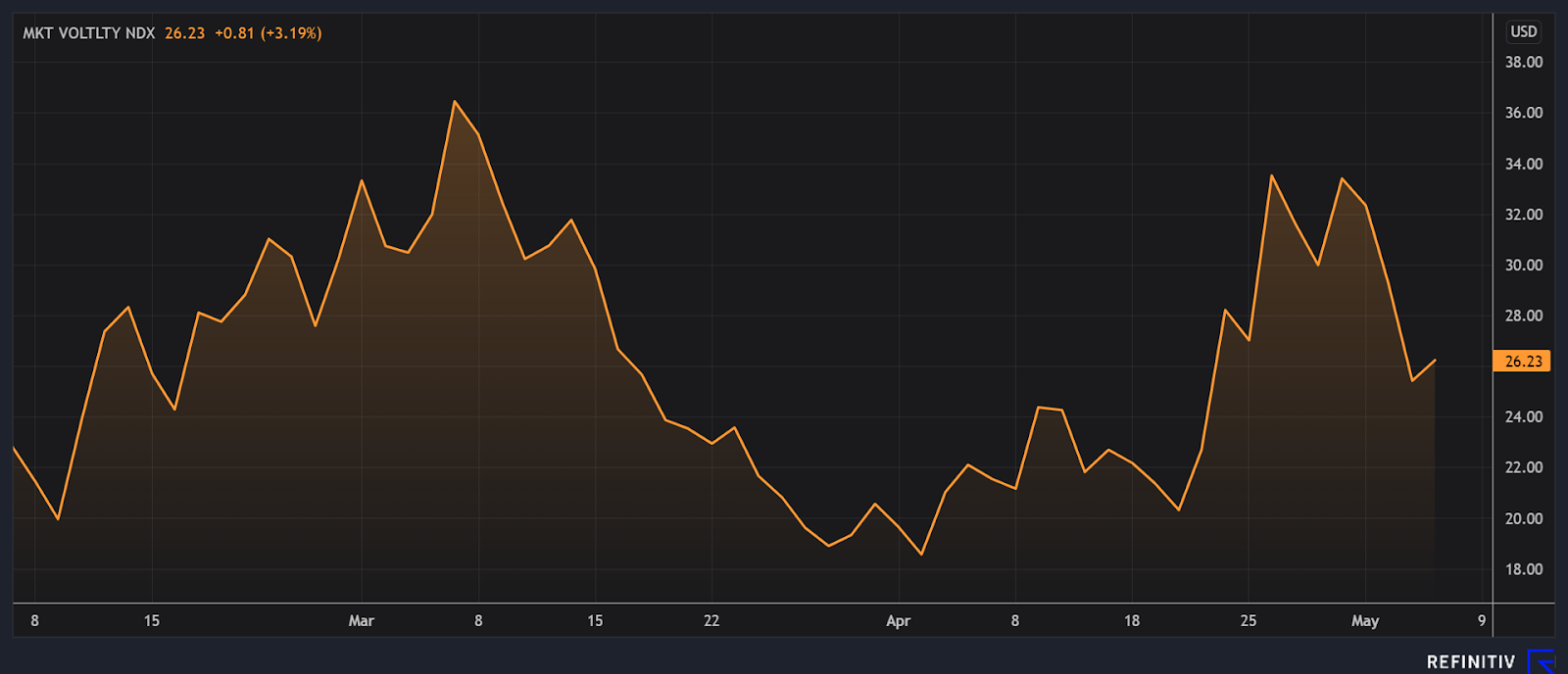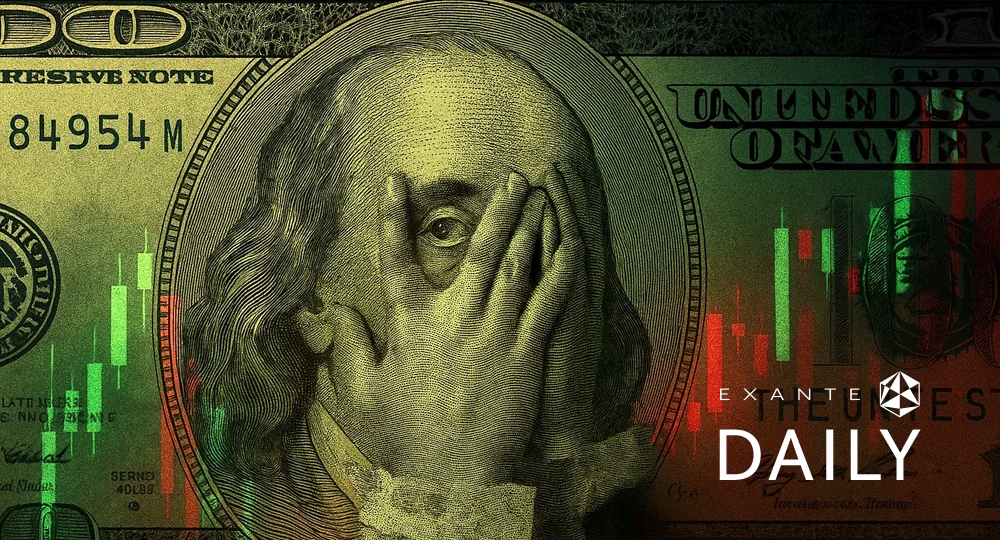
EXANTE Macro Insights

By Renée Friedman, PhD
The week in summary:
Welcome to Macro Insights #23. This week markets were on edge as equities and bonds had their worst monthly selloff in over a decade while all eyes remained focused on the US Federal Reserve rate rise decision. Concerns about a slowing economic growth and the ability of the Fed to engineer a “soft” landing, mixed earnings from some big growth companies, the continuing crisis in Ukraine, the potential banning of Russian energy by the EU and the impact it will have on those EU economies growth and inflation prospects, and supply chain problems continuing due to pandemic-related lockdowns in China, have all led to increased market volatility over the past week.

VIX 3 months: source: Refinitiv
On Wednesday the Fed, in a unanimous decision, set its target federal funds rate to a range between 0.75% and 1% with Chairman Jerome Poweel stating that further 50 basis-point hikes were on the table for the next two meetings. The Fed's balance sheet, which soared to about $9 trillion during the COVID-19 pandemic, will be allowed to decline by $47.5 billion per month in June, July and August and the reduction would increase to as much as $95 billion per month in September. According to Refinitiv, interest rate futures continued to reflect bets the Fed will raise its policy rate to the 3%-to-3.25% range by the end of the year. Nominal wage growth has been high over the past few months, particularly for those with wages in the lowest percentiles, with average wage growth at above 5% in Q1 2022. However real wage growth is not keeping up with inflation and this is reflected in recent consumer confidence numbers: the University of Michigan consumer sentiment for the US was revised lower to 65.2 in April from 64 in March while theThe Conference Board consumer confidence index nudged down to a reading of 107.3 in April from a slightly upwardly revised 107.6 in March.The most important concern for investors is whether the tightening in financial conditions will be fast enough to cool the economy enough without causing it to go into recession.
In the UK, the Monetary Policy Committee (MPC) of the Bank of England (BoE) decided to raise rates for a fourth time, from 0.75% to 1.0%. The BoE said most policymakers believed "some degree of further tightening in monetary policy may still be appropriate in the coming months". The vote was 6-3 for the quarter-point rise from 0.75%. The three that voted against the 25bps rise actually called for a bigger increase to 1.25% to stamp out the risk of the inflation surge getting embedded in the economy. This was the BoE's fourth consecutive rate hike since December making it the fastest increase in borrowing costs in 25 years. The BoE said most policymakers believed "some degree of further tightening in monetary policy may still be appropriate in the coming months". It also revised up its forecasts for price growth to show it peaking above 10% in Q4. It said inflation in the UK would peak later than in other big advanced economies due to the cap on household energy tariffs, which jumped up 54% in April and will probably rise a further 40% in October. Real post-tax household disposable income - a measure of living standards - is forecast to fall 1.75% this year. While the bank predicts the U.K. will avoid a technical recession, it said output will collapse by close to 1% in the final quarter of this year. It kept its forecast for economic growth this year at 3.75%, but 2023 annual GDP is expected to shrink by 0.25%. It is only expected to grow 0.25% in 2024. The new forecast also saw wage growth rising 5.75%, and unemployment continuing to drop this year but rising to 5.5% by 2025. The BoE also said it would consider beginning the process of actively selling bonds purchased under quantitative easing, becoming the first major central bank to do so.
In Europe, the situation remains very different to the US. wage growth in Europe is still barely visible but underlying pressures are there as we saw this past week when a large influential trade union, IG Metall, in Europe’s largest economy, Germany, put forth a 8.2% wage rise demand. Many analysts are suggesting that the European Central Bank (ECB) may already have left it too late to stop wage growth feeding into inflation. ECB board member Isabel Schnabel said in an interview with the German newspaper Handelsblatt, “the data are backward-looking and we need to pursue a forward-looking monetary policy so we can’t afford to wait until a wage-price spiral has already set in before responding.” Unemployment is at a record low 6.8% across the EU and employment, at nearly 162 million, is higher than it has ever been. However, structural unemployment, particularly in how it impacts young people, is still an issue in Europe in a way that it isn’t in the US or the UK. However, there is an increasing likelihood that the ECB will be forced to take action. As noted by ECB chief economist Philip Lane on Thursday at a conference at Brussels-based think tank Bruegel, "I think it’s clear that at some point we’re going to be moving rates, not just once, but over time, in a sequence,". He did, however, emphasise that the entire process of normalisation and level of the neutral policy rate is a bigger issue than the date of lift-off.
Energy prices reacted to the European Union proposal to phase out Russian oil this year, a move that could boost demand for natural gas and coal. However, this is dependent on agreement by all 27 EU member states and the East European countries have already said they would find it particularly difficult to adapt in the suggested time frame; the plan, if agreed by member states, would take effect in six months for crude and in eight months for diesel and other oil products. Even if all states agreed to the ban, the EU could find it almost impossible to implement, given Europe's complex distribution network and challenges in tracking crude once it is blended or refined. And OPEC+ agreed on Thursday to maintain its plans for a gradual oil output increase amounting to 432,000 barrels per day in June. In short, no real relief should be expected in energy prices any time soon.
Things to look out for this coming week
- In Europe on Friday there is German industrial production data, Spanish industrial output data, and Italian retail sales data. On Tuesday there is Italian industrial output data. There is also the Eurozone ZEW economic sentiment survey, the German ZEW current situation survey, and the German ZEW Economic sentiment survey. On Wednesday there is German CPI and the German Harmonised Index of Consumer prices. The European Commission will also release its latest economic growth forecast on Wednesday.
- In the US on Friday look out for average hourly earnings, nonfarm payrolls, labour force participation, underemployment rate and unemployment rate data. On Wednesday there is CPI and CPI ex food and energy data as well as EIA crude oil stocks change data. In the US on Thursday is initial and continuing jobless claims data. PPI and PPI ex food and energy.
- In the UK on Tuesday there is the British Retail Consortium (BRC) Like-For-Like Retail Sales data. On Thursday there is GDP data There is also Industrial production and manufacturing production data.
Also on Monday there is Chinese import, export and trade balance data. On Wednesday is the Chinese CPI and PPI. The Chinese central bank, the People’s Bank of China (PBoC) has been actively trying to support the economy through a series of rate cuts. Since mid-April, the renminbi has fallen sharply against the USD, by about 4%.
Are you still hungry?
Food prices and the cost of farming are going up. According to the International Food Policy Research Institute, recovery of global demand has been a key driver of the surge in international agricultural commodity prices, more so than COVID-related supply chain disruptions. Globally markets have tightened as a result of stronger-than-usual demand for animal feed and agricultural products for industrial use, with demand from China exercising major influence. And, of course, the prices continue to be driven by rising energy prices, rising wages, rising transportation costs, and rising fertiliser prices.
The United Nations Food and Agriculture Organisation (FAO) revealed that food prices reached their highest levels ever in March 2022. The FAO Food Price Index *(FFPI) averaged 159.3 points in March 2022, up 17.9 points (12.6%) from February, making a giant leap to a new highest level since its inception in 1990. The latest increase reflects new all-time highs for vegetable oils, cereals and meat sub-indices, while those of sugar and dairy products also rose significantly.
The World Bank estimates the pandemic has led to an additional 97 million extremely poor people compared to pre-pandemic projections. Higher food prices could drive many to require food aid. The fact is that food-price inflation has a much greater direct impact on people’s lives. It also reflects more complex causes, and addressing it effectively requires a completely different set of strategies than just tightening monetary policy to combat inflation. Policymakers are concerned that increased food prices could create conflict elsewhere. According to a report by the Global Network Against Food Crises (GNAFC) the main driver pushing 139 million people in 24 countries/territories into acute food insecurity is ongoing conflict followed by weather extremes, and economic shocks mainly due to the fallout from the COVID-19 pandemic.
And, although this may seem more of a problem for developing and emerging economies, the effects are being felt in Europe and the UK too. Agricultural commodity markets are suffering the consequences of the Russian-Ukrainian crisis, notably in the price rise of fertilisers and the possible shortages on the cereal markets. UN Secretary-General Antonio Guterres said on Wednesday the problem of global food security could not be solved without restoring Ukrainian agricultural production and Russian food and fertiliser output to the world market. Given that the Russian-Ukrainian crisis does not look like it will be resolved any time soon, what does that mean for consumers, farmers, food production and distribution companies, and for commodity markets overall?
It means that we could see governments imposing new trade restrictions, as is already happening in the cases of Russia (wheat), Argentina (beef), Indonesia (palm oil) and China (fertilisers) with the consequent effect that these commodities prices will remain high on global markets, reduce the margins of food production and distribution companies, and heighten geopolitical tensions. It also means that governments may be more tempted to step in and provide direct subsidies or other support. The EU (and US) have been increasing their own domestic agricultural subsidies; in the case of the EU the increase is reflected in a support package agreed in March of €500 million for farmers most affected by higher input costs and the closure of export markets (EU countries can complement this support up to 200% with national funds). The EU has also (temporarily) granted farms the right to produce t crops on land set aside within the EU, while maintaining full greening payments for farmers. This will affect the biodiversity goals set forth in the EU’s Green deal and thus set the EU up for an internal struggle over the next few years. It may also affect the development of biofuel production in the EU, which would, inadvertently, keep the EU more dependent on imported energy sources. So the (relatively) rich governments of the EU, may face the same situation as many poor people, heat or eat?
DISCLAIMER: While every effort has been made to verify the accuracy of this information, EXT Ltd. (hereafter known as “EXANTE”) cannot accept any responsibility or liability for reliance by any person on this publication or any of the information, opinions, or conclusions contained in this publication. The findings and views expressed in this publication do not necessarily reflect the views of EXANTE. Any action taken upon the information contained in this publication is strictly at your own risk. EXANTE will not be liable for any loss or damage in connection with this publication.
本文提供給您僅供資訊參考之用,不應被視為認購或銷售此處提及任何投資或相關服務的優惠招攬或遊說。金融商品交易涉及重大損失風險,可能不適合所有投資者。過往績效不代表未來表現。




